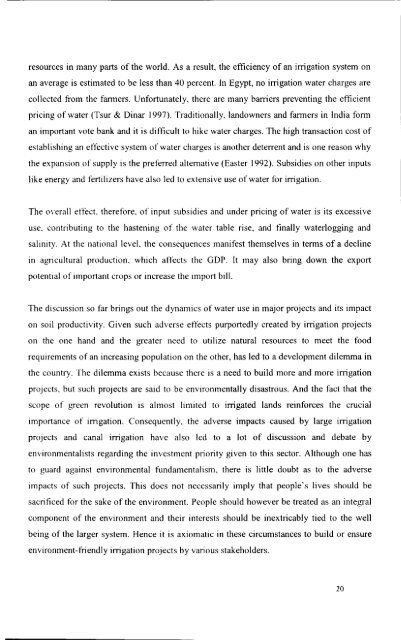Water Users Association and Irrigation Management - Institute for ...
Water Users Association and Irrigation Management - Institute for ...
Water Users Association and Irrigation Management - Institute for ...
You also want an ePaper? Increase the reach of your titles
YUMPU automatically turns print PDFs into web optimized ePapers that Google loves.
esources in many parts of the world. As a result, the efficiency of an irrigation system on<br />
an average is estimated to be less than 40 percent. In Egypt, no irrigation water charges are<br />
collected from the farmers. Un<strong>for</strong>tunately, there are many barriers preventing the efficient<br />
pricing of water (Tsur & Dinar 1997). Traditionally, l<strong>and</strong>owners <strong>and</strong> farmers in India <strong>for</strong>m<br />
an important vote bank <strong>and</strong> it is difficult to hike water charges. The high transaction cost of<br />
estahlishing an effective system of water charges is another deterrent <strong>and</strong> is one reason why<br />
the expansion of supply is the preferred alternative (Easter 1992). Subsidies on other inputs<br />
like energy <strong>and</strong> fertilizers have also led to extensive use of water <strong>for</strong> irrigation.<br />
The overall effect, theretore. of input subsidies <strong>and</strong> under pricing of water is its excessive<br />
use. contributing to the hastening of the water table rise, <strong>and</strong> finally waterlogging <strong>and</strong><br />
salinity. At the national leveL the consequences manifest themselves in terms of a decline<br />
in agricultural production. which affects the GOP. It may also bring down the export<br />
potential of important crops or increase the import bill.<br />
The discussion so far brings out the dynamics of water use in major projects <strong>and</strong> its impact<br />
on soil productivity. Given such adverse effects purportedly created by irrigation projects<br />
on the one h<strong>and</strong> <strong>and</strong> the !,1feater need to uti Iize natural resources to meet the food<br />
requirements of an increasing population on the other, has led to a development dilemma in<br />
the country. The dilemma exists because there is a need to build more <strong>and</strong> more irrigation<br />
projects, but such projects are said to be environmentally disastrous. And the fact that the<br />
scope of !,1feen revolution is almost limited to irrigated l<strong>and</strong>s rein<strong>for</strong>ces the crucial<br />
importance of irrigation. Consequently, the adverse impacts caused by large irrigation<br />
projects <strong>and</strong> canal irrigation have also led to a lot of discussion <strong>and</strong> debate by<br />
environmentalists regarding the investment priority given to this sector. Although one has<br />
to guard against environmental fundamentalism, there is little doubt as to the adverse<br />
impacts of such projects. This does not necessarily imply that people's lives should be<br />
sacrificed <strong>for</strong> the sake of the environment. People should however be treated as an integral<br />
component of the environment <strong>and</strong> their interests should be inextricably tied to the well<br />
being of the larger system. Hence it is axiomatic in these circumstances to build or ensure<br />
environment-friendly irrigation projects by various stakeholders.<br />
20
















